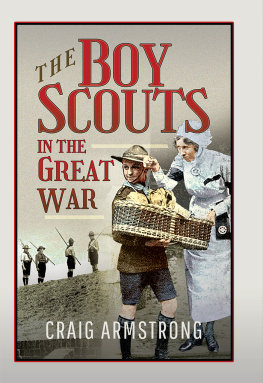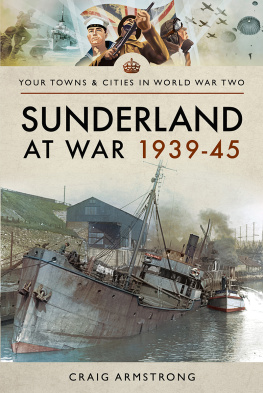Craig Armstrong - South Shields at War 1939–45
Here you can read online Craig Armstrong - South Shields at War 1939–45 full text of the book (entire story) in english for free. Download pdf and epub, get meaning, cover and reviews about this ebook. year: 2020, publisher: Pen and Sword, genre: Non-fiction. Description of the work, (preface) as well as reviews are available. Best literature library LitArk.com created for fans of good reading and offers a wide selection of genres:
Romance novel
Science fiction
Adventure
Detective
Science
History
Home and family
Prose
Art
Politics
Computer
Non-fiction
Religion
Business
Children
Humor
Choose a favorite category and find really read worthwhile books. Enjoy immersion in the world of imagination, feel the emotions of the characters or learn something new for yourself, make an fascinating discovery.
- Book:South Shields at War 1939–45
- Author:
- Publisher:Pen and Sword
- Genre:
- Year:2020
- Rating:4 / 5
- Favourites:Add to favourites
- Your mark:
- 80
- 1
- 2
- 3
- 4
- 5
South Shields at War 1939–45: summary, description and annotation
We offer to read an annotation, description, summary or preface (depends on what the author of the book "South Shields at War 1939–45" wrote himself). If you haven't found the necessary information about the book — write in the comments, we will try to find it.
South Shields at War 1939–45 — read online for free the complete book (whole text) full work
Below is the text of the book, divided by pages. System saving the place of the last page read, allows you to conveniently read the book "South Shields at War 1939–45" online for free, without having to search again every time where you left off. Put a bookmark, and you can go to the page where you finished reading at any time.
Font size:
Interval:
Bookmark:

YOUR TOWNS & CITIES IN WORLD WAR TWO
SOUTH SHIELDS
AT WAR 193945
As ever, for my parents.
YOUR TOWNS & CITIES IN WORLD WAR TWO
AT WAR 193945
CRAIG ARMSTRONG

First published in Great Britain in 2020 by
Pen & Sword Military
an imprint of
Pen & Sword Books Ltd
Yorkshire Philadelphia
Copyright Craig Armstrong, 2020
ISBN 978 1 47389 121 0
eISBN 978 1 47389 123 4
Mobi ISBN 978 1 47389 122 7
The right of Craig Armstrong to be identified as Author of this work has been asserted by him in accordance with the Copyright, Designs and Patents Act 1988.
A CIP catalogue record for this book is available from the British Library.
All rights reserved. No part of this book may be reproduced or transmitted in any form or by any means, electronic or mechanical including photocopying, recording or by any information storage and retrieval system, without permission from the Publisher in writing.
Typeset by Aura Technology and Software Services, India.
Pen & Sword Books Limited incorporates the imprints of Atlas, Archaeology, Aviation, Discovery, Family History, Fiction, History, Maritime, Military, Military Classics, Politics, Select, Transport, True Crime, Air World, Frontline Publishing, Leo Cooper, Remember When, Seaforth Publishing, The Praetorian Press, Wharncliffe Local History, Wharncliffe Transport, Wharncliffe True Crime and White Owl.
For a complete list of Pen & Sword titles please contact
PEN & SWORD BOOKS LIMITED
47 Church Street, Barnsley, South Yorkshire, S70 2AS, England
E-mail:
Website: www.pen-and-sword.co.uk
Or
PEN AND SWORD BOOKS
1950 Lawrence Rd, Havertown, PA 19083, USA
E-mail:
Website: www.penandswordbooks.com
The seaside town of South Shields stands on the southern bank of the River Tyne and in 1939 was a vital centre of industry. By far the most important industry in the town and its immediate hinterlands was that of shipbuilding and repairing but there were also extensive marine engineering works, paint shops and coal staithes which loaded coal from the Durham coalfield for transport to London. Mixed in amongst this were other industries such as light engineering and ancillary industries which supported both the shipbuilding and mining industries.
The town was also a popular tourist destination, particularly for industrial workers from County Durham and weekend and day trips to the seaside were an extra source of income. South Shields, standing at the mouth of the Tyne was extremely vulnerable to aerial attack and, indeed, the town had been visited by Zeppelins in the First World War while the town (and Tynemouth across the river) had been the intended target for bombardment by elements of the German fleet during that conflict.
South Shields also had an extensive non-white British population as foreign seamen had, for many years, congregated in the town for service in the Merchant Navy. Foremost amongst these communities was that of men and women from Yemen. A strong Yemeni British community had existed since the 1890s and the first Arab Seamans Hostel in the country had been opened in South Shields in 1909. By the end of the First World War the Yemeni community in South Shields had grown to well over 3,000 and men of Yemeni descent who served, alongside many other South Shields men, in the Merchant Navy had lost their lives in the conflict; something which was repeated in the Second World War. There had sometimes been tensions between the communities and riots had broken out in 1919 and 1930, but by the beginning of the Second World War attitudes were softening and most, but certainly not all, welcomed the contribution of the Yemeni population.
Like many North-East communities, South Shields had suffered extremely badly during the Depression and, like others in the area, had strong links with the armed forces and particularly with the Merchant Navy. While many local men made their living as members of the Army, Royal Navy and, to a smaller extent, the RAF, a huge number of local men served in the Merchant Navy and it is estimated that South Shields suffered the greatest loss in this service per capita during the war.
The slump in shipbuilding orders had a devastating effect on the industry as a whole, but the effect was felt hardest on Tyneside where the local population was so dependent upon shipbuilding and its ancillary industries. Whilst the industry had been in decline for some time, it was the drastic slump of the early 1930s that accelerated this feature. This downward trend manifested itself in every region, was especially marked in the principal shipbuilding regions, and, within this group, in the Northern Region and in Scotland.
At one point during the 1930s less than 3 per cent of berths were in use on the river, whilst, in Jarrow, unemployment in the industry stood at 80 per cent. The rot had started in the previous decade when launches dropped by a third, year on year. By 1930 the depression of the industry was biting hard at the yards of Tyneside. The north-east yards had launched some 600,000 tons during the first year of the decade but a year later the total stood at only 68,000 tons, a fall of 88 per cent; by 1932 the Tyneside yards launched only 24,000 tons. This was largely due to an absolute lack of orders for oil tankers, a type of vessel that had been the staple of many of the larger Tyneside yards (north-east yards had previously built two thirds of all British oil tankers and one third of the world total). The lack of orders hit the shipyards of the Tyne particularly hard and, by 1931, unemployment in the industry nation-wide stood at 60 per cent whilst on Tyneside the figure was put at over 70 per cent. In March 1931 the Newcastle Employment Committee had reported that there were 78,452 people unemployed on Tyneside. Over 60 per cent of those previously employed in the shipbuilding industry were registered as unemployed, whilst the numbers of idle from the marine engineering field had practically trebled over the previous year.
The slump in the shipbuilding industry, more than in any other single industry, was responsible for the heavy pre-war unemployment on Tyneside. In 1932 the unemployment index in this industry stood at 79 per cent and, This again exemplified the regions over-dependence upon a small number of key industries throughout the period and the results of a downturn in specific sectors highlighting the economic vulnerabilities of the area. The importance of shipbuilding and ship-repairing work to Tyneside can be seen by the fact that the north-east coast area (including Tyneside) contained 26 per cent of all shipyard workers in Britain in 1930. This was greater than that of Clydeside and twice the combined total of Merseyside and Barrow.
In addition to rising levels of unemployment employers, understandably, attempted to cope with the depression by decreasing wages and by restricting working hours. Both of these policies were very unpopular with both the unions and the workforce, leading as they did to a reduction in take-home pay. Restriction of working hours also led to a greater degree of inefficiency, lessening of training schedules and a decline in standards of plant maintenance. Of all the types of engineering firms it was those engaged in marine work that suffered the second greatest losses of hours with only the textile industry being more badly affected. Some relief was gained by the transfer of some engineering workers to other fields, but the lack of newer light engineering concerns on Tyneside continued to be a significant barrier.
Font size:
Interval:
Bookmark:
Similar books «South Shields at War 1939–45»
Look at similar books to South Shields at War 1939–45. We have selected literature similar in name and meaning in the hope of providing readers with more options to find new, interesting, not yet read works.
Discussion, reviews of the book South Shields at War 1939–45 and just readers' own opinions. Leave your comments, write what you think about the work, its meaning or the main characters. Specify what exactly you liked and what you didn't like, and why you think so.











